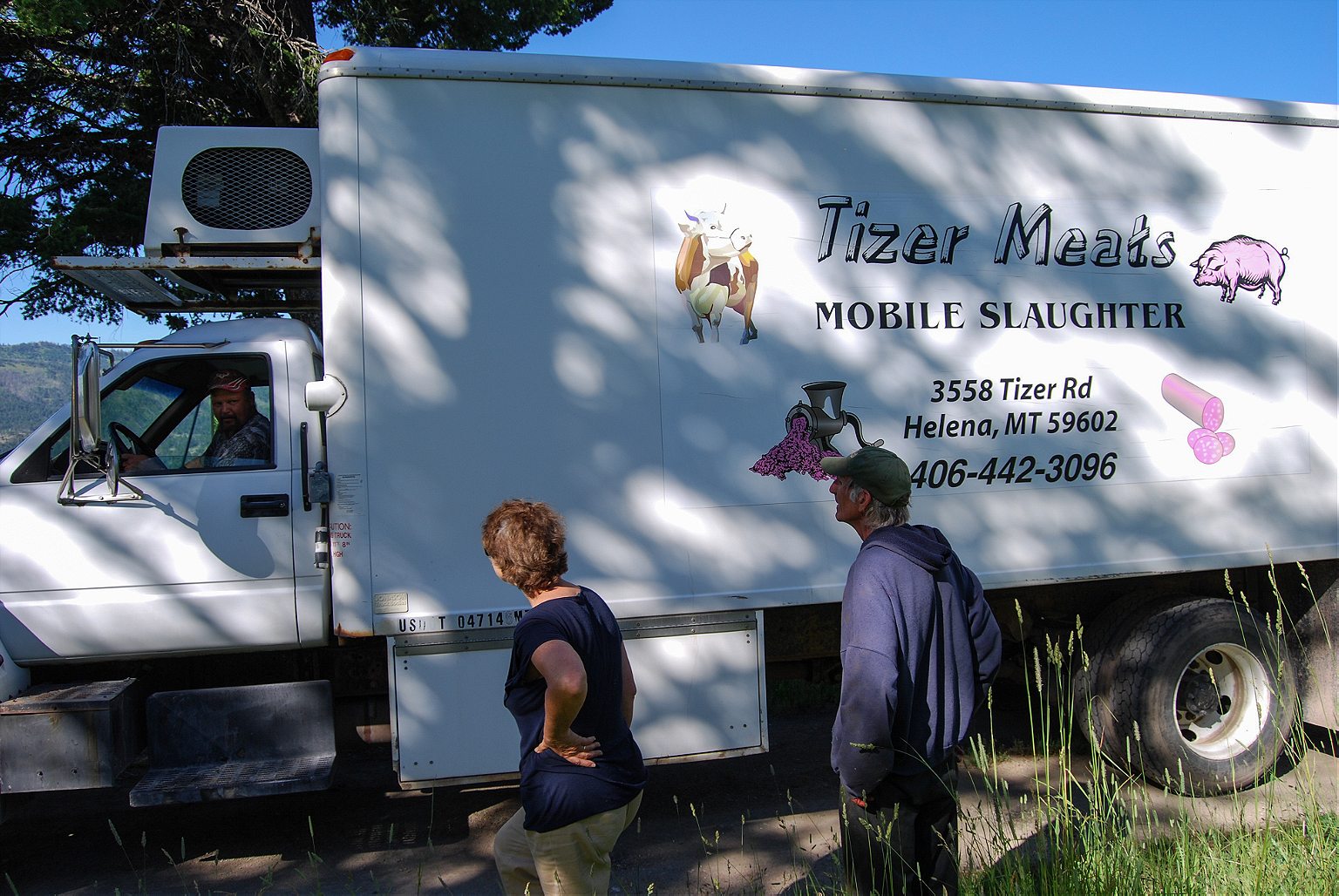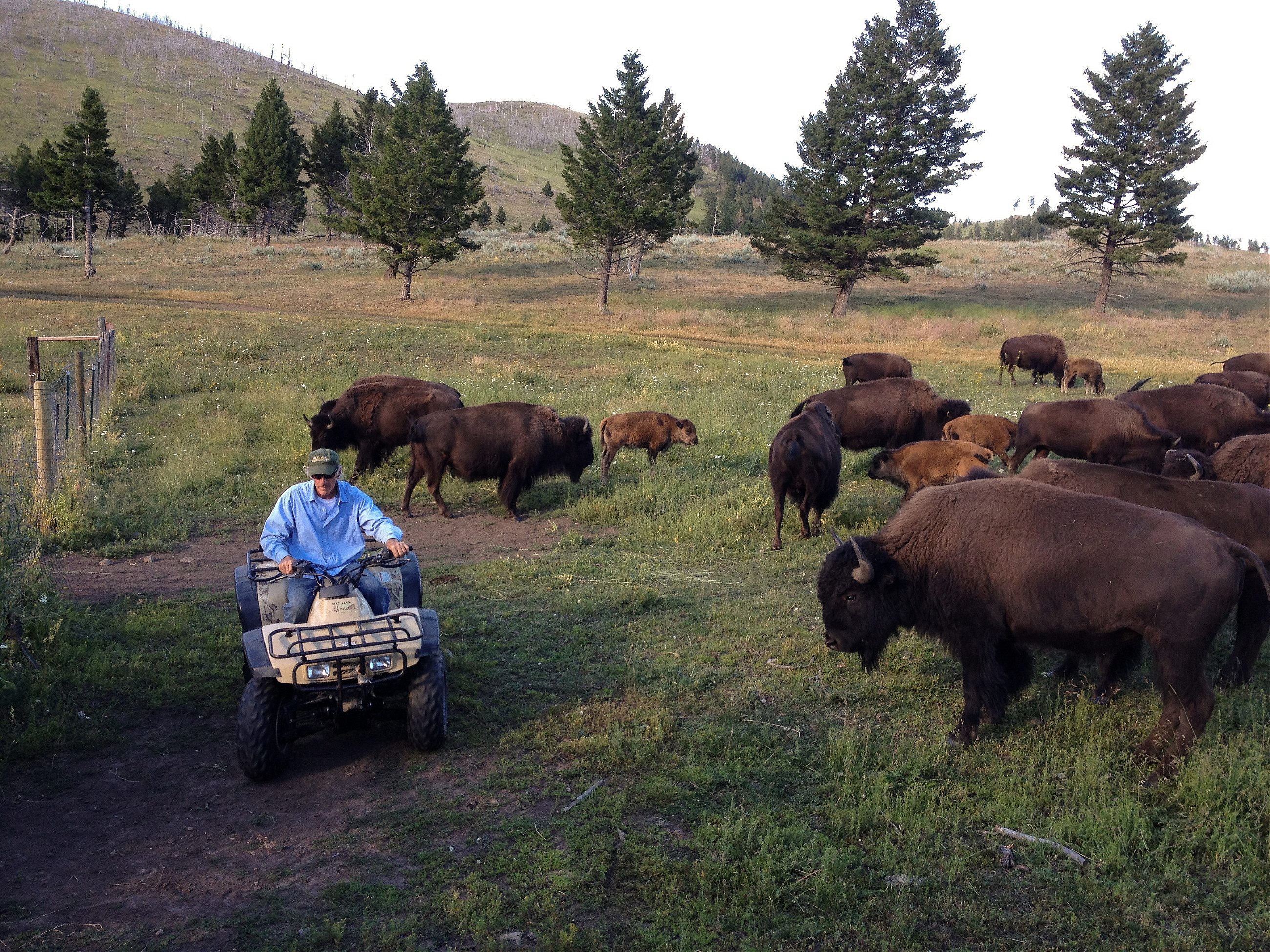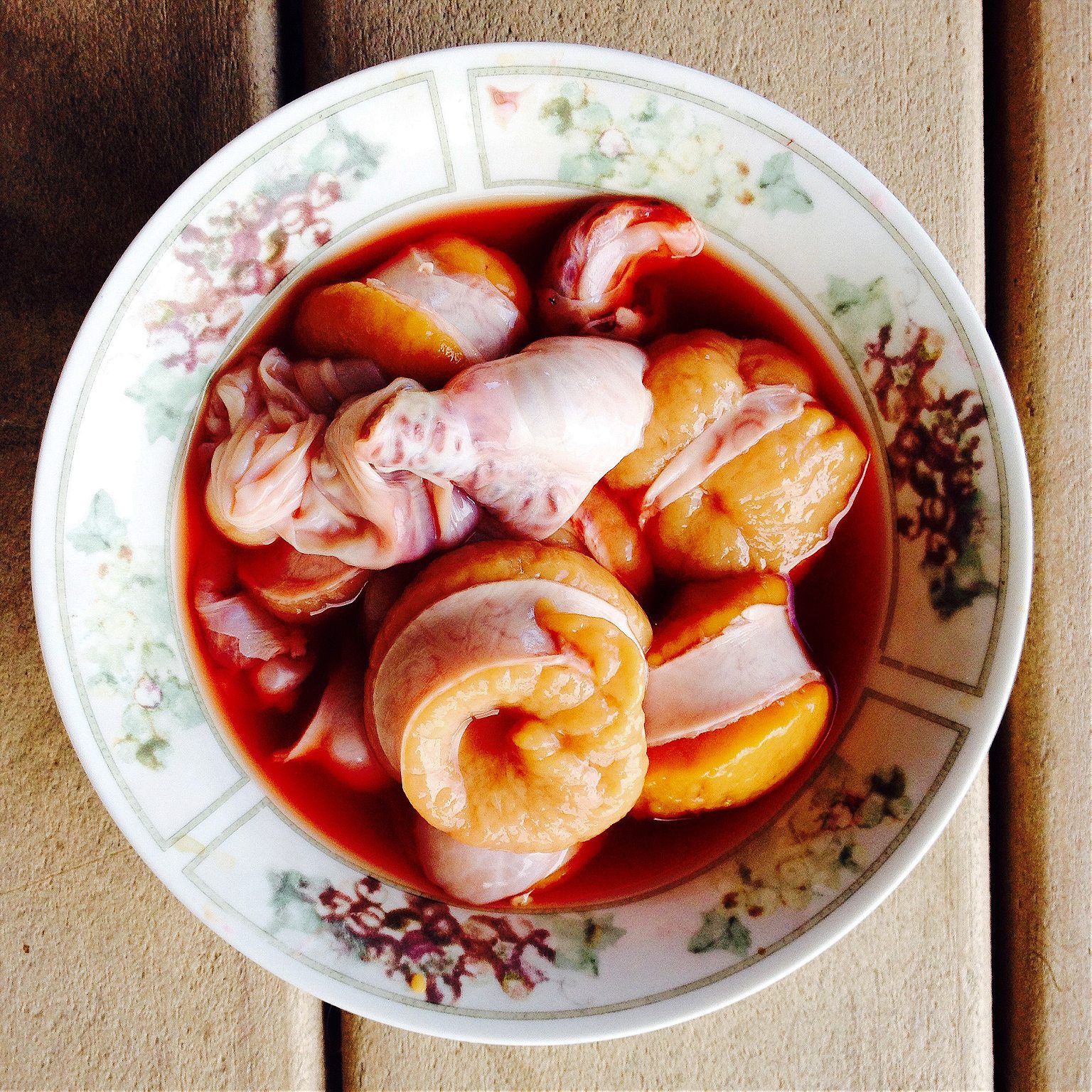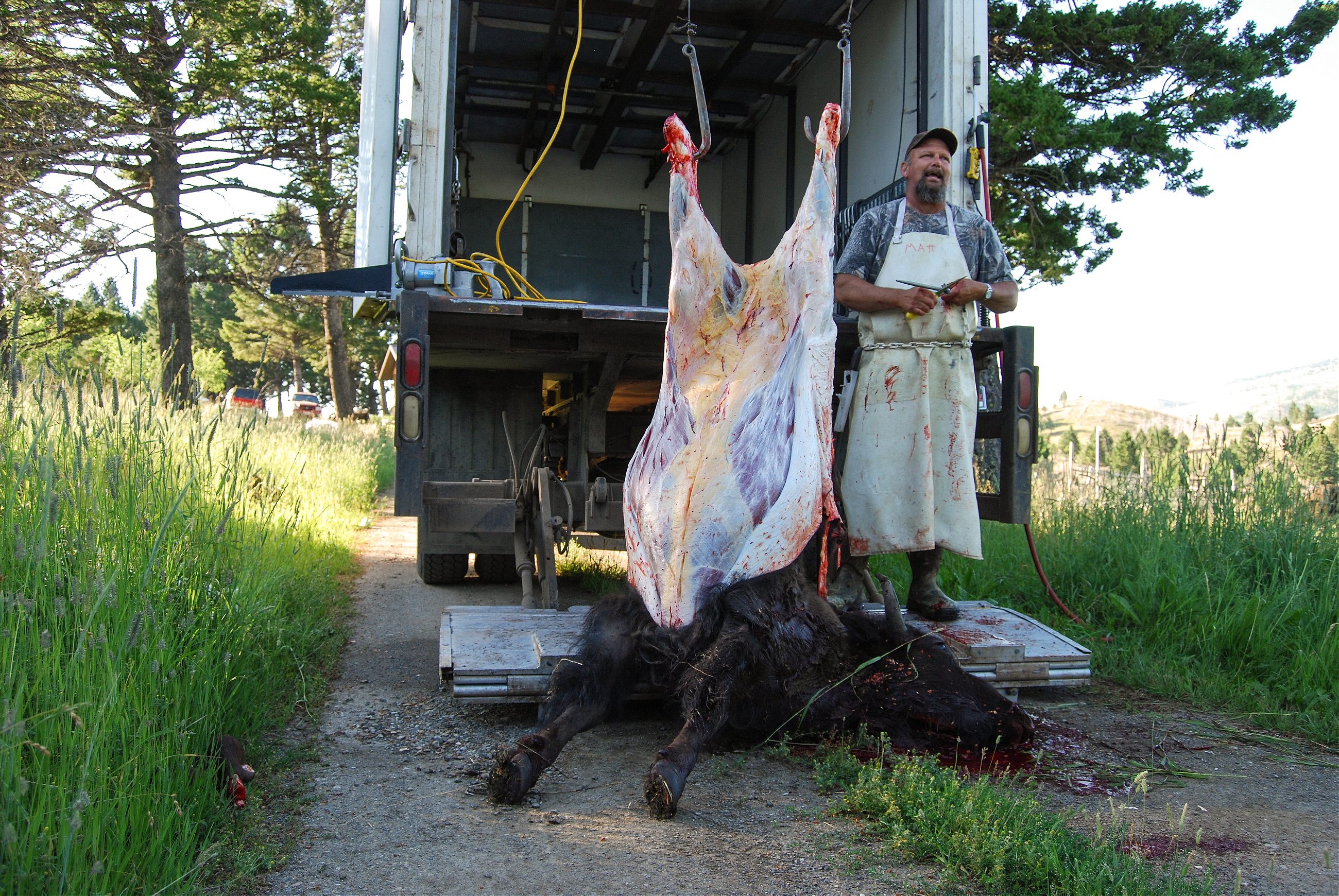In the Montana wilderness, you don’t go to the butcher—the butcher comes to you.
She watches us calmly with her big, brown eyes as we approach the pen in the middle of a pasture scattered with spiky Douglas firs, juniper trees, and light-green sagebrush. The Big Belts, a Rocky Mountain hill range in western Montana, rise around the field, and the waters of Canyon Ferry Lake glimmer on the horizon. Matt Elvbakken, the man hired to kill the 900-pound bison, is wearing camouflage rubber boots, a camouflage t-shirt, and a camouflage baseball cap. He crouches down and looks her straight in the eye. A long, yellow Winchester .243-caliber rifle rests in the crook of his sunburnt arm. “It’s just not your day,” Elvbakken says to the animal.
The bison bends her dark brown shaggy head to eat some oats and the butcher takes aim. We are close enough to feel her heat and see the houndstongue stickers caught in the soft fuzzy bonnet between her horns. When he shoots her in the head, the loud shot pierces the bright morning air and echoes through the Big Belt hills. The animal lurches forward violently, front hooves tucked under her chest, and collapses to the ground. The undigested oats from the last meal spill out and her amber eyes, with horizontal pupils like the eyes of sheep and goats, are wide open. Elvbakken calls for a sharp knife to cut the carotid artery and jugular vein and uses it to quickly bleed the animal out. Bright red blood gushes from her neck into the field. The sun is blazing but the herd of 80 bison is out in the open, gathered around the pen and watching.
I had come to Big Sky Country to learn how to raise bison sustainably. Annual supermarket and retail sales of American bison meat, commonly known as buffalo, top $250 million, according to the National Bison Association, and bison burgers are now regular menu items from California to Maine. On their off-the-grid Wild Echo Bison Ranch in Townsend, Montana, wildlife biologists Craig and Pam Knowles don’t use antibiotics or hormones on sick buffalo, and strive to protect both the health of the land and the animals. When it comes time to sell meat to an interested customer, the Knowleses avoid trucking their buffs to the nearest slaughterhouse in order to minimize any trauma their animals might feel. “If we had our way, every one of our animals would be put down in the field,” says Pam.

That’s where butcher Matt Elvbakken and his Winchester come in. Elvbakken has the tall, solid frame you might expect of a man who slaughters cattle, hogs, sheep, moose, bear, deer, elk, antelope, and the occasional buffalo for a living; he describes himself as “53-years-old, 6’2” and a whopping 270 pounds of rompin’ stompin’ romance!” He learned the ropes of the meatpacking business working the kill floor and boning room at Midland Empire Packing Company in Billings, Montana, which has since closed. Now, Elvbakken’s got his own meat processing company in Helena, Tizer Meats.
In 2009, Tizer Meats bought a used frozen-pizza delivery truck and turned it into a butcher’s shop on wheels. Elvbakken installed a power inverter, water pump, and insulated 250-gallon water tank, and added a winch with two lines to the back for hoisting carcasses from the ground. The meat from five beef cattle or 15 sheep and hogs can hang neatly in the back of the truck. With that finished, he had his own slaughterhouse on wheels.

Elvbakken will bring his mobile slaughter unit, as the truck is technically called, to ranches within a 100-mile radius of his Helena shop. This may sound like a long haul. But in this stunningly beautiful part of rural Montana, you can expect to drive an hour under the vast cerulean sky for a cone of huckleberry ice cream before the rodeo or country karaoke night at the local watering hole. Off the main highways, cell phone reception is spotty, roads are rutted and unpaved, and it’s not uncommon to glimpse wild mustang, moose, and elk. Ranchers like the Knowleses live miles from their nearest neighbor and they value their self-sufficiency—the ranch’s electricity is powered by solar panels and a wind turbine. But living in the wilderness does have its challenges, especially where the bison are concerned, and that’s what makes Elvbakken’s services so appealing.
Fall is the busiest season for slaughtering game, cattle, and hogs. Sheep season picks up in the spring. The butcher says it’s a good day when the truck is full and the travel short: “It’s usually feast or famine in that we will get two or three beef cattle at several different locations and possibly some swine or sheep as well. There are days we don’t slaughter anything and others where we can’t get everything.”

If the consolidation in the meatpacking industry continues at its current rate, Elvbakken may be in for more business. The majority of America’s meat is processed at 60 large plants—down from 63 in 2010—that handle millions of animals annually, according to the U.S. Department of Agriculture. The number of smaller facilities that max out at 10,000 head of cattle has also declined by 12 percent between 2001 and 2013. The shrinking number of packing houses is especially hard on the nation’s smallest ranchers, many of whom must make long trips from the farm to slaughterhouse and pay high processing costs to bring local meat to market. Then there’s the impact of the transport on the animal. There is a wide range of opinions on this, but it’s hard to imagine being cooped up in a trailer for too many hours can be good for any living creature.
To help solve this slaughterhouse bottleneck and to meet the growing demand for local meat, mobile slaughter units are popping up across the country. Farmers who want to sell meat commercially across state lines must get their animals slaughtered and processed at a meat plant that has been approved by the U.S.D.A. Government meat inspectors are required to be on the floor any time these plants are in operation. However, the U.S.D.A. has also certified nine refrigerated trucks to act as rolling slaughterhouses in Washington, Arkansas, California, Nebraska, Colorado, New Mexico, New York, and Texas. Ranchers elsewhere hire butchers like Elvbakken to do custom slaughtering for meat that will not be resold in grocery stores but will be eaten on the farm or by customers who have bought a quarter or a half of an animal.

Today’s job takes two hours and will cost the Knowleses $75 plus $1 for each mile Elvbakken drives from Helena. Usually the butcher pulls his truck into the field close to the site of the kill to skin and dress the animal. But Craig and Pam are worried the herd will become aggressive if the animals see and smell one of their own being slaughtered beside them in the field. Instead, the job will be finished out-of-sight of the herd. So Craig hoists the heifer’s bloody carcass into the back of a battered red farm truck and Pam drives the truck up the hill to the ranch house where the mobile slaughter unit is parked.
But the herd has gotten wind of the slaughter. Already one of the bulls, Ini, is prancing nervously around the edges of the pen where the heifer had been shot. The rest of the animals—strong, lean, and much bigger than cattle—seem agitated, too. The herd begins to run at the truck, eyes bulging, hooves kicking up dust. Their horns, which point in odd directions and sprout from massive heads weighing a couple hundred pounds, appear dangerously close to goring Craig, who is standing in the back of the truck with the dead heifer. Even though the charging animals weigh tens of thousands of pounds, they would be no match for the 5,000-pound truck; still, Pam accelerates and Craig barely manages to open and close the gate before the big lead buffalo charges up, knocking into the fence. “She’s the mother of the buff that was killed,” Craig says.
From the unpredictable behavior of large animals to the rifles and sharp blades being used for the kill, field slaughters can be extremely dangerous business. Elvbakken says they also take more time than slaughtering at a brick-and-mortar plant. Still, in these remote parts, ranchers require Elvbakken’s services. Revenue from the mobile slaughter truck has helped provide the capital for Tizer Meats to expand; the company has plans to build a brick-and-mortar state-inspected slaughter facility in Helena.

Back at the Knowles’s ranch house, Elvbakken stands behind his truck. Three razor-sharp knives and a steel knife sharpener hang from a white chain wrapped around his waist. His name is emblazoned in big, red, block letters across the front of a rubber-coated apron. When Pam and Craig drive up with the dead heifer, Elvbakken begins by cutting out the bison’s hefty black tongue, then winches the carcass into the air by its hind legs. Unmoved by the scarlet blood now staining his hands, forearms, apron, and boots—it’s just another day’s work—he talks about falling beef prices and modernizing his shop while methodically removing the animal’s hooves, hide, and head. He pulls out the organs in an explosion of gas and hot vapor and a messy pile of intestines falls to the ground beneath the carcass. After the buffalo has been gutted, he quarters the carcass with a chainsaw and rinses the parts with a spray-nozzled hose. The meat is so fresh it doesn’t smell like much of anything. But a passing glance at the buffalo’s blood-spattered severed head, minus the tongue, could move even the hungriest meat-eater to lose their appetite.
This is the 100th bison that Elvbakken has slaughtered, and when the job is done, the pearl-white and dusky red quarters of meat hanging from the deep recesses of his truck resemble a 17th century Dutch still-life. Every bit of the animal not destined to be packaged and frozen—tongue, liver, heart—will be eaten on the ranch by the Knowleses and their guests, the farm cats, and the dogs. No waste. Elvbakken starts up the truck. A few fields over, the bison settle down under a shady copse of Douglas firs, their tails flicking rapidly to whip off flies.